The adorable squeaks, the hops and skips through their hay, and of course the post-food zoomies are only a few reasons that people have fallen in love with guinea pigs as pets. A wonderful starter pet for those unsure if they want the full-time commitment of a dog, guinea pigs bring as much joy as any pet.
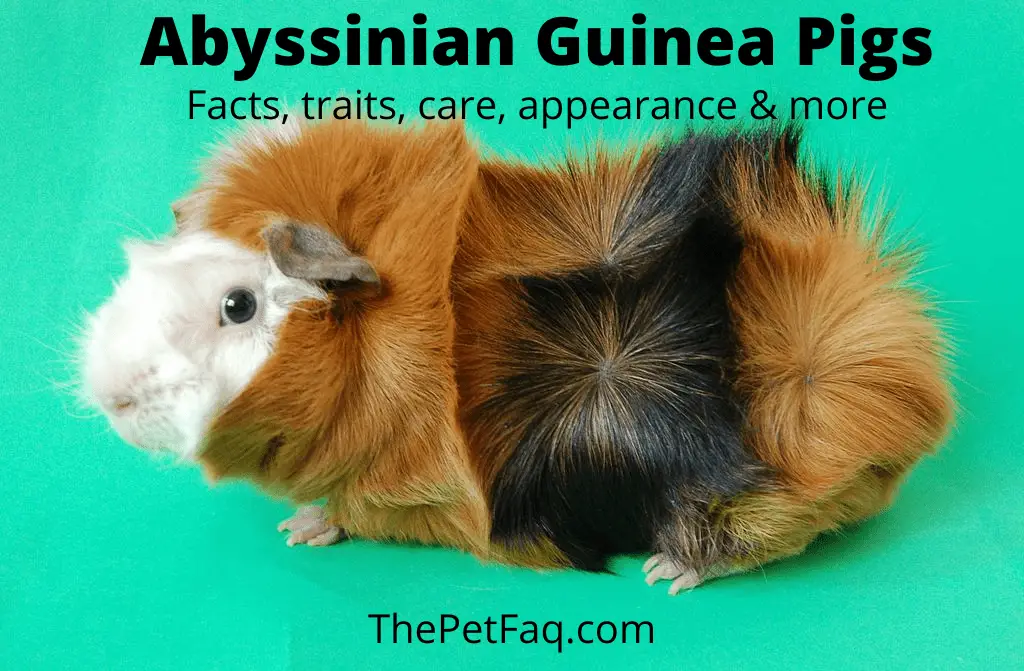
While it seems you can find a guinea pig at almost any pet store and through your local humane society, there is plenty to learn about them! Coming in different colors, sizes, and personalities, guinea pigs are varied and should be researched before deciding to share your home with them. Today, we’re putting the spotlight on the Abyssinian Guinea Pig. We’ll cover the basics, such as their appearance and their origins, and of course, we’ll also go over how to best care for your piggy.
Abyssinian Guinea Pig Fact Sheet
| Breed name | Abyssinian Guinea Pig |
| Weight | Females 1 to 2 pounds, males 2 to 2.5 pounds |
| Size | 8 to 12 inches fully grown |
| Diet | Mostly hay, smaller amounts of pellets, fruits, and vegetables |
| Lifespan | 5 to 7 years |
| Coat | Short with many rosettes |
| Coat colors | Many, including brown, white, black, roan, or multicolor. |
| Temperament | Affectionate, energetic, social, intelligent |
| Experience | Beginner-friendly |
| Price | $20 to $50 per cavy |
Origins of the Abyssinian Guinea Pig
Though their name is Abyssinian, which is an African country now known as Ethiopia, Abyssinian
guinea pigs are actually from South America. Part of the cavy family, which includes the
capybara, guinea pigs are descended from hardy mountain climbing rodents and have wild
cousins that can still be found in South America.
After the exploration of the New World in the 16th century, Abyssinians became a popular pet, especially with those who had children due to their social nature and ease of care. Today, the breed is one of the most recognizable guinea pigs and continues to be a great pet for children and families.
Appearance of the Abyssinian Guinea Pig
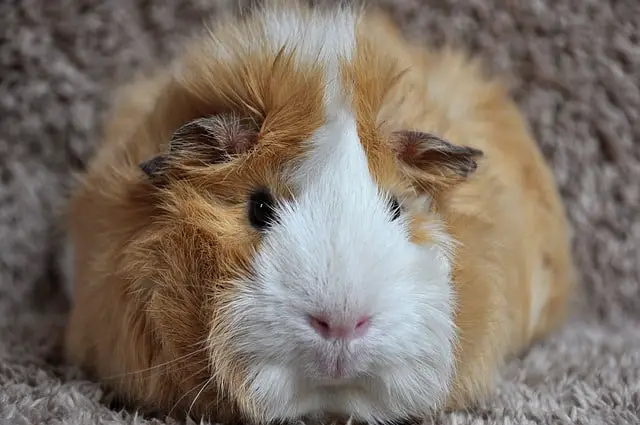
Abyssinian Guinea Pigs are the most distinct of all breeds because of their wild hairdos! Often
referred to as collicks, these patterns of rough hair are actually called rosettes.
Each Abyssinian has six to eight rosettes and while not common, they can sometimes have up to ten. With such unique coats, these little guys come in all sorts of colors and patterns:
- Self – one solid color such as white or black.
- Roan – a blend of light and dark hair
- Dutch – a two tone color combination
- Tortoiseshell – blocks of two solid colors, such as black and brown
Size
Female and male Abyssinians differ in size and weight, with females coming in at 1 to 2 pounds, and males at 2 to 2.5 pounds. Males are usually about an inch longer than a female, with average lengths between 8-12 inches. Of course, these can all differ with a piggy’s diet environment, and genetics.
Temperament of the Abyssinian Guinea Pig
- Social
- Affectionate
- Energetic
- Gentle
- Vocal
- Intelligent
With over thirty breeds of guinea pigs recognized, the Abyssinian guinea pig is one of the most popular because of its unique coats and easy-going temperament. Highly social, AGPs will need a companion, aka partner in crime, as these piggies are known to find mischief.
More energetic than most guinea pigs, they need plenty of room to zoom around and boredom-busting activities. Be sure to have a large pen or cage for your piggy so that they can zoom around as much as they like.
Abyssinians only sleep for a few minutes at a time and have around 20 hours of active time per day, so be sure that their pen or cage is suitable for them to stretch their little legs.
These cavies are praised for their docile and gentle personalities that are perfect for families with children. They’ll keep the little ones entertained with their high energy and playful natures.
In addition, Abyssinians are the most vocal of all the guinea pig breeds and this can take some getting used to. Be sure you’re prepared for a talkative companion in your home, especially during feeding time. Lots of squeaks and chattering will fill the room!
Furthermore, Abyssinian Guinea Pigs are also very intelligent and can be taught a few simple tricks and commands such as “come”, “stand”, and to jump through hoops. Teaching them tricks and commands will also help keep them active and bond with you and your family.
Lifespan and Health of Abyssinian Guinea Pigs
Guinea pigs give birth to litters, with the most common size being three. However, a female Abyssinian guinea pig can have up to six babies at once! Growing quickly, the babies will double in size by 8 weeks and are around 8-10 inches when they’re celebrating their 16th week of living. They will continue to grow to reach the standard 10-12 inches when they’ve fully matured.
Most guinea pigs have a lifespan of between 4-8 years. AGPs fall within that, averaging about 5-7 years. As with all pets, you should be aware of potential health problems and schedule regular vet visits to keep your pet as healthy and happy as possible. Abyssinians are generally a healthy breed but do have some common ailments. According to the Merck Veterinary Manual, the most common problems for Abyssinian guinea pigs are pneumonia, diarrhea, scurvy, and urinary problems.
The breed is also known for its sensitive stomachs, which can cause gas and diarrhea. Always watch what your piggy is eating and make sure that it is a consistent diet. Now, scurvy is an odd thing for a guinea pig to catch as we’ve mostly eradicated it in the modern world, however, unlike many other animals, these little rodents do not naturally produce vitamin C and so must be given it in their diet.
One of the ways can tell if your guinea pig does not have enough vitamin C in their diet is by checking if they have a rough coat and swollen feet. Be sure to check your piggy daily for anything abnormal.
If you believe there to be something wrong to be with your piggy, always take them to a vet for a checkup.
Socializing Abyssinian Guinea Pigs
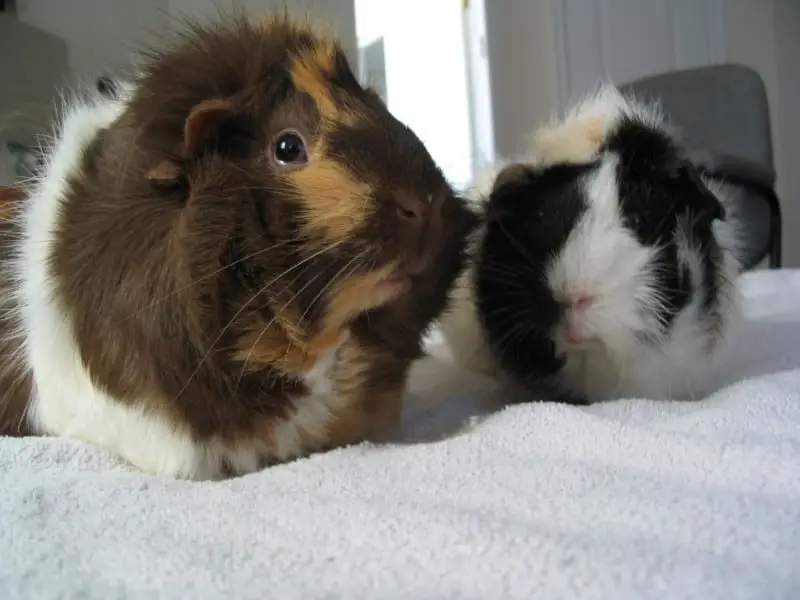
Most guinea pigs are social creatures, and Abyssinians especially so. Because of this, you’ll want to consider having a playmate for your cavy. Guinea pigs are prone to loneliness and the stress of being alone is bad for them. No one wants their pet to feel lonely!
The cost of adding a second piggy is minimal, as they can share the same pen, and feeding your piggies is budget-friendly. We highly recommend adding a companion for your cavy as it’ll bring joy to both you and your furry companion. It’s not necessarily required to have two guinea pigs of the same breed living together. Abyssinians get along perfectly fine with other guinea pig breeds such as the Texel or the American Guinea pig.
If you do not already have a bonded pair or littermates, introducing separate guinea pigs must be approached with caution. As guinea pigs have a hierarchy and not all animals get along, start by placing them in a large pen at opposite corners from each other. Let them slowly meet without interference and have a towel on hand in case you need to separate them.
When more than an hour has passed and your piggies are playing together, snuggling, or chasing each other around, it’s safe to move them into their new home together. You’ll have the joy of watching
your pet play with a companion and your piggy will lead a happy life!
If they do not appear to be bonding, place them in separate enclosures but close together so that they can become familiar with each other’s smells and sounds. It could take a few days for them to decide that they’d like to be friends.
It is important to take note of their ages as during the 3-5 month age period, piggies are figuring out their hierarchies and are maturing into adults. This can cause them to be rough and even aggressive to their cage mates, especially in pairs of male/male or female/female.
Even we as humans take a bit to decide if we like a person and your cavy will be no different when choosing their housemates.
Abyssinian Guinea Pig Care Guide
While caring for a guinea pig is relatively easy and they’re a great choice for first-time pet owners, there are some essential things you need to know. For instance, you should know how to house them, what to feed them, how to groom them, and what toys they enjoy playing with.
Feeding your Abyssinian Guinea Pig 🍅
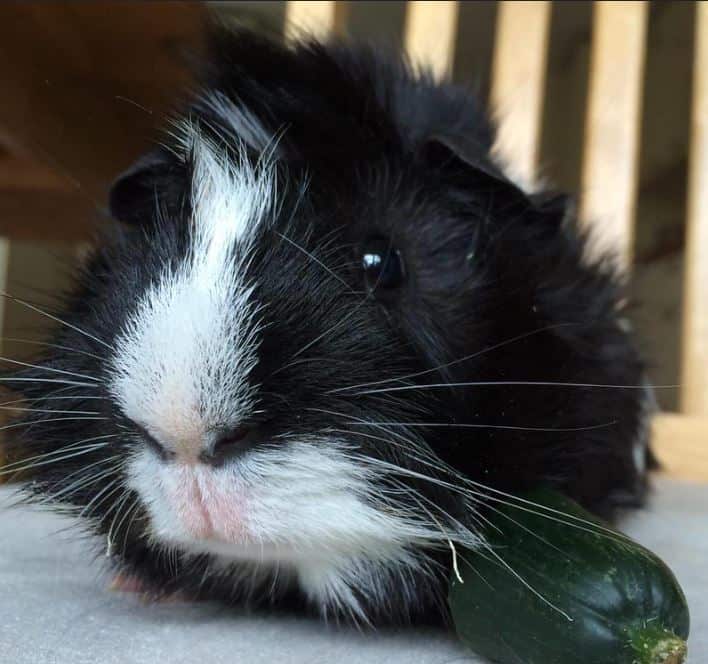
- Majority of their food intake should be hay
- Pellets fortified with vitamin C
- Fresh fruits & vegetables. Especially leafy greens such as kale, lettuce, and parsley
- The occasional treat
Just like any pet, you should pay specific attention to your piggy’s diet. Because weight is an important factor to your piggy’s health, they will need to be on a specific diet without too much variation, as they do have sensitive stomachs.
To start, your piggy must always have access to timothy hay. Hay is over 80% of a guinea pig’s diet and is essential to their diets. But hay is for horses, right? Nope! Hay is important to your piggy because it helps keep their digestive tract running smoothly and limits the growth of their teeth. Be sure to provide
unlimited access to timothy hay daily.
Like humans, guinea pigs cannot create vitamin C and must be given it in a food source. When choosing the right pellets for your little guys, make sure it is fortified with vitamin C without any extra additives. While it sounds fun to feed your piggy a pellet that has tasty fruits in it, they are usually additive dyes and artificial flavors that could harm a guinea pig’s sensitive stomach. A ¼ cup of pellets a day will supplement their diet but be sure to refresh them daily as they can quickly crumble and mold.
We all love the squeaks that our guinea pig friends make and they’ll become extra vocal when you introduce fresh vegetables into their diet! You’ll want to feed them one cup per piggy per day. Dark green, leafy vegetables such as romaine lettuce, kale, and parsley are great choices and will give your piggies the nutritional values they need.
Like us, piggies appreciate variety in their daily vegetables so don’t be afraid to mix it up and feed different greens throughout the week. As a bonus treat, red & green peppers and broccoli are packed full of vitamin C and make great daily options to keep that variance going. Other veggies such as carrots, tomatoes, and zucchini can also be fed once a week.
Treats
Who doesn’t love to give their beloved pets treats? Everyone, of course! But be cautious when feeding your piggies treats. Too many treats can result in weight gain or diarrhea.
This doesn’t mean you can’t treat or reward your piggies, just do so in moderation. Fresh fruit such as blueberries, banana slices, or even kiwi make great treats and also help to add variance to their diets. If they do develop diarrhea, remove the fresh produce from their diet for a few days and let their stomachs settle on a steady diet of hay and pellets before reintroducing the fresh produce.
Litterbox training an Abyssinian Guinea Pig
To help keep your pet’s enclosure as clean as possible, we recommend litter box training your cavy. Guinea pigs are intelligent creatures, especially the Abyssinian, and are easy to teach simple tricks and behaviors. For instance, you can easily train them to use the litter box!
Start by placing a box filled with bedding in a dark corner. Guinea pigs like to sleep, eat, and relieve themselves in places they feel safe, so a dark or covered litter box will help them feel secure.
Then, place their food dishes near the dark corner or covered box. Guinea pigs, like most small mammals, like to do their business where they eat. Why? It’s a safety mechanism from the wild. By hiding their fecal matter and their food, predators are less likely to find them. Guinea pigs have no natural fighting abilities besides their sharp teeth, so they have evolved to find places to hide for safety.
Over time, your guinea pig will associate the dark, covered corner as a safe space to eat and go to the bathroom. Try not to change these locations around too soon or your guinea pig will forget to use those designated spaces. There will occasionally be poop pellets and/or urine spots throughout their enclosure, but with litter box training, this will be minimal.
When training Abyssinians, patience is key. They can learn a lot as long as you give them the appropriate time to do so.
Grooming Abyssinians ✂
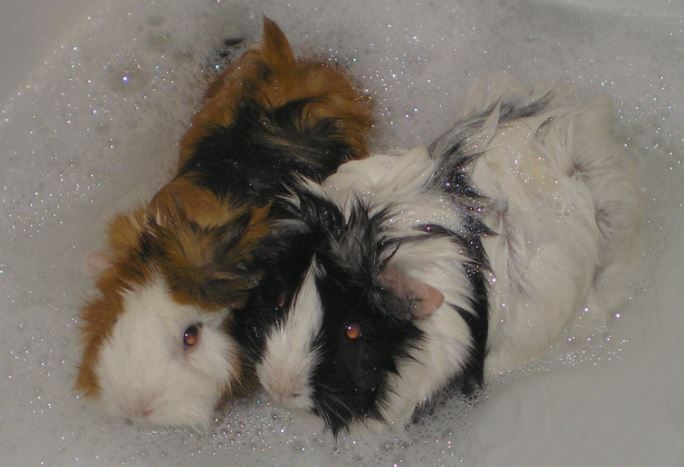
Because of the Abyssinian’s gorgeous coats, they require more grooming than most guinea pigs. It is recommended to brush your cavy every two to three days to clear out tangles and mats, which can be painful for them.
Brushing out their unique coats has more benefits than just keeping them looking beautiful, it’s also a great way to bond with your pet, as guinea pigs are highly social. Regular brushing can also help detect potential health issues by allowing you to see the skin beneath their coats.
It is also recommended to give them a bath every so often to keep their coats clean. Bathing also makes grooming their rosettes easier.
Piggies also require nail trimming, which may seem daunting, but with careful handling and some tasty treats, you can keep your guinea pig looking ship shape!
Another important aspect of grooming is ensuring their cage is clean. I suggest removing all the bedding, which can be fleece, newspaper, or store-bought bedding, and wash it thoroughly or throw it away once at least once a week. Guinea pigs like to be clean, and a clean cage also means you won’t have an odor in your home.
Housing your Abyssinian Guinea Pig 🏡
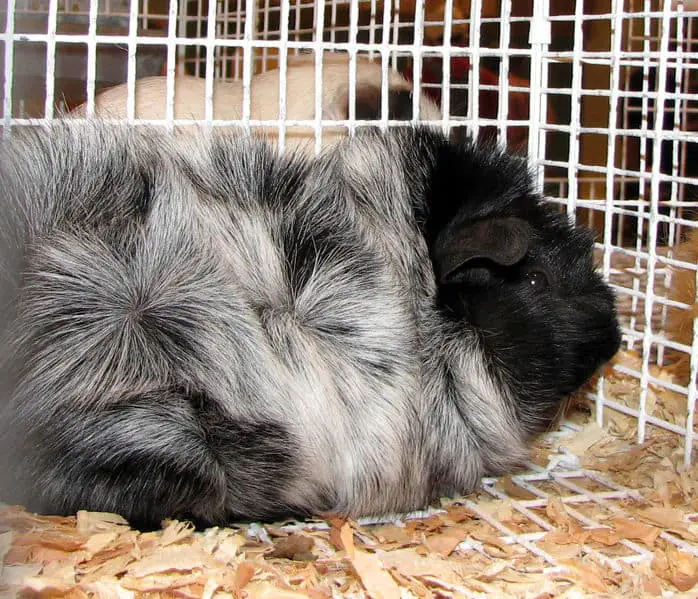
The minimum guinea pig cage size for a single piggy is 7.5 square feet. However, a bigger cage is almost always better.
Much like we have our homes to go to at night and sleep safely in, cavies require a space for them to hide in and sleep. They can become stressed out from being in the open. This is due to them being prey animals and a natural instinct is to hide. Placing an igloo or even a simple box in their cage works perfectly for these little guys and you can find them curled up in them, usually cuddling together for warmth and comfort.
Guinea pigs are playful, especially the Abyssinian who is known to be highly energetic, so each enclosure should have toys, ramps, and plenty of space to run! Don’t overcrowd their enclosure though as piggies like to be able to stretch their legs and being cramped can stress them out. There are many toys out there for your furry friends to play with! Just be sure that they are piggy-safe.
An ideal toy would be something for them to chew on or climb on, such as a log ramp or a chewable toy. A cheap, good, toy could also be an old cardboard box you have lying around your house, as they can chew, climb, and hide in them!
Try hanging bits of fleece around and watch as they dart in and out of them. But be cautious, never use hamster balls or exercise balls for guinea pigs. They are not designed for guinea pigs and can cause spinal injuries.
Abyssinian Guinea Pig Price
Abyssinians are among the most common guinea pig breeds. Because of this, they’re in high supply and not very expensive. On average, they will cost between $20 and $50 from a reputable breeder.
It’s also possible to buy them from a pet shop, usually for a cheaper price, but this is not recommended. Animals bought from pet shops are usually less well cared for and might develop issues later on. In addition, breeders usually treat the cavies they breed more humanely.
Frequently asked questions:
Do Abyssinian guinea pigs need haircuts?
It’s recommended to occasionally give your cavy a haircut if their hair is too long. Especially around their rear, the hair can get urine stuck on it which is not pleasant for them. Do make sure that you cut their hair very carefully!
Do Abyssinian Guinea pigs Shed?
All guinea pigs shed which is one of the reasons why brushing and grooming are so important. Abyssinians do not shed as much as some of the longer-haired breeds, such as the Peruvian, but they do indeed shed.
Do Abyssinians bite?
Abyssinian guinea pigs are generally calm and docile and do not typically bite. They only bite if they feel threatened and feel as if they have no other choice.
Final words
Guinea pigs make such wonderful pets and are absolutely amazing to watch as they play
and squeak around their pens. AGPs are so funky looking with their rosettes but it just makes
them more snuggly and with a bit of grooming, looking their best.
These piggies make the perfect pet for young children learning how to care for a pet and an easy pet for parents to look after. They bring joy into your home by being smart, curious, and always playful. If you adopt one of these adorable animals, one of your favorite things will be when they learn the sound of the fridge opening and begin squeaking. We hope you enjoy your new Abyssinian Guinea Pig!
- How Long Do American Eskimo Dogs Live? Important Factors and Care Tips - September 29, 2023
- Do American Bulldogs Need Grooming? Essential Tips and Care Guidelines - September 29, 2023
- Do Bengal Cats Enjoy Playing? Essential Tips for Keeping Them Active - September 29, 2023